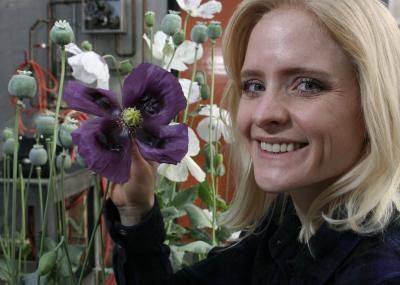Milestone in quest for cheap antimalarial
Advertisement
Researchers striving to create a less expensive version of a life-saving antimalarial drug, artemisinin, have cleared a major hurdle, according to a new report in the journal Nature. Two and a half years ago, a University of California, Berkeley, team led by Jay D. Keasling, UC Berkeley professor of chemical engineering and bioengineering, succeeded in engineering bacteria to make a chemical precursor of artemisinin - the best drug available today to cure malaria. The team's ultimate goal was to retool the microbe's metabolism to perform as much of the drug synthesis as possible in order to sidestep the expensive laboratory synthesis needed to make artemisinin. That synthesis would have increased the drug's cost beyond the researchers' ambitious target of 25 cents per dose.
UC Berkeley researchers are trying to create microbial factories that will produce more cheaply an antimalarial drug, artemisinin, that now is extracted from the wormwood plant, Artemisia annua. They now have nearly achieved that goal by engineering the production of artemisinic acid, one chemical alteration away from artemisinin. The fact that the researchers have not yet been able to produce artemisinin itself is not a disadvantage, they said, since drugs currently on the market - all made from extracts of the wormwood plant, Artemisia annua - are synthetic derivatives of both artemisinic acid and artemisinin.
"This is probably as close to artemisinin as we are going to get in microbes. The rest is going to be done by chemistry," said Keasling. His lab partnered with the San Francisco-based Institute for OneWorld Health, a nonprofit pharmaceutical company, and Emeryville, Calif.,-based Amyris Biotechnologies in late 2004 on a $43 million grant from the Bill and Melinda Gates Foundation to develop low-cost artemisinin drugs using Keasling's genetically engineered microbes.
Keasling noted that his team achieved its recent feat in yeast, not E. coli bacteria. Bacteria breed faster and are often the microbes of choice, but the ability to get the drug out of both bacteria and yeast provides flexibility in achieving the goal of complete synthesis of artemisinin within another four years, he said.
Despite its achievement, the team cautioned that a microbe-produced version of artemisinin will not be on the market soon. It added that the current method of production - extraction from the wormwood plant grown by farmers in Asia - will be essential in the next five to 10 years until production and widespread distribution of the less costly alternative becomes possible.
"While we have made a lot of progress in the past two years, there still are a lot of unknowns," Keasling said. Keasling is director of the UC Berkeley Synthetic Biology Center and of the Lawrence Berkeley National Laboratory's Synthetic Biology Department, and a UC Berkeley member of the California Institute of Quantitative Biomedical Research (QB3).
Artemisinin derivatives, in combination with other drugs, have proven nearly 100 percent effective against malaria, and thus represent a major hope for the 300-500 million people each year who become infected with malaria, and the more than 1.5 million people - largely children in Africa and Asia - who die. Even at $2.40 per person for a cure, however, the cost is too great for most developing countries.























































